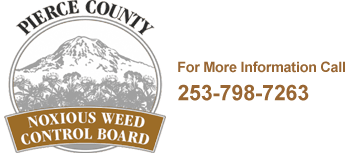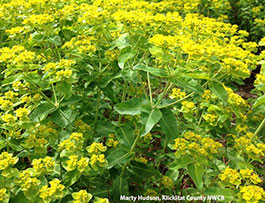Eggleaf Spurge
Euphorbia oblongata • Class A |
||
| Family Name: | Euphorbiaceae | |
| Common: | oblong spurge, Balkan spurge | |
| Genus: | Euphorbia | |
| Species: | E. oblongata | |
| Description: |
Eggleaf Spurge is an upright perennial up to 3 feet tall. Stems are covered with fine white hairs growing from a woody root crown and branch out at the tip. Egg shaped, oblong leaves are alternately arranged on the stem, and are smooth, hairless and about 2 1⁄2 inches long, with finely toothed margins. Yellow flower clusters bloom in spring and summer, consisting of all male flowers and one small female flower. Flower clusters have yellow bracts at the base followed by a whorl of yellow green leaves. Seedpods are waxy in appearance and when mature, ripened pods forcefully eject their seeds. |
| Why Is it a Noxious Weed? |
It was introduced as a garden ornamental and escaped cultivation. It’s closely related to, and exhibits invasive and competitive strategies similar to, leafy spurge (Euphorbia esula) which is listed as a Washington State Class B noxious weed. |
| Where Does it Grow? |
Plants can form dense patches that displace desirable vegetation. It can invade a wide range of habitats including damp meadows, streambanks, forest floors, dry hillsides, roadsides and waste areas. |
| Facts: |
All plants contain a caustic milky sap when cut, which can irritate skin, eyes and digestive tracts of humans and animals. |
| Control Options: |
|
| More Information: |
For more information on this noxious weed Download our Flyer or visit Washington State Noxious Weed Control Board Here
|
| More Pictures: |






 Pierce County Noxious Weed Control Board • 9200 122nd St E, Puyallup, WA 98373 • 253-798-7263
Pierce County Noxious Weed Control Board • 9200 122nd St E, Puyallup, WA 98373 • 253-798-7263